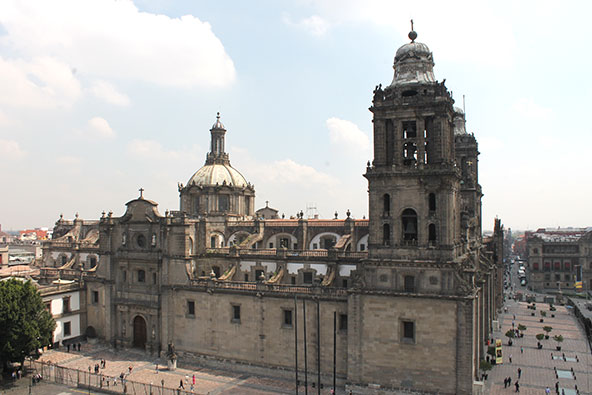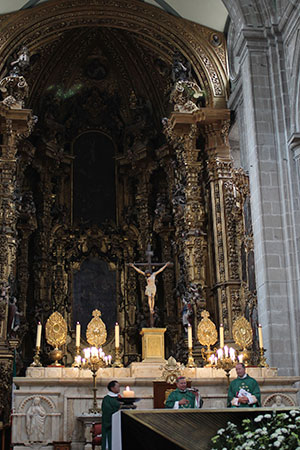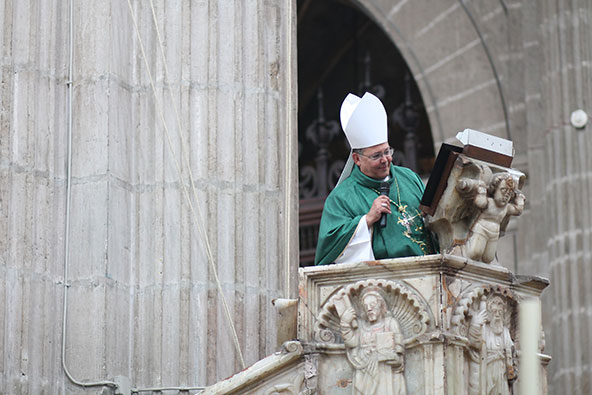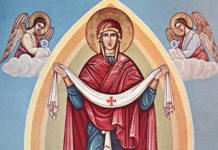

The Metropolitan Cathedral of the Assumption of Mary — the cathedral of the archdiocese of Mexico City — is built upon Aztec ruins. It was built to meet the growing needs of the Church in Mexico — a Church which grew thanks to the apparition of the Blessed Mother as Our Lady of Guadalupe in 1531.
Plans for the cathedral began sometime around 1570, after the people outgrew the cathedral ordered by Hernán Cortés. It is similar to Spanish cathedrals of the time — five aisles, 14 chapels, a dominant altar and two large bell towers. Unlike the typical easterly construction, the cathedral faces south to greet the main square, or zocalo.
The Aztecs began building what has become Mexico City on a dry lake bed that hasn’t always stayed dry. That has caused many problems, and many buildings in the city are slowly sinking into the ground. During the Great Flood of 1629, St. Juan Diego’s tilma was moved to the cathedral. The local Church finished initial construction of the cathedral on Dec. 22, 1667, 94 years after it began. But the finishing touches weren’t placed on the construction of the cathedral until Aug. 15, 1813, just over 200 years ago.
Pope Francis wrote Cardinal Norberto Rivera Carrera, archbishop of Mexico, a letter commemorating the 200-year anniversary of completion (READ IT HERE). The cathedral’s “stones are silent witnesses of the many that have entered it to open their heart to God, to ask for forgiveness, to pray for favors, to praise and bless Him for all the love He manifests to us every day,” the pope wrote, in part. “Let us gather the best of that spiritual heritage and continue lifting our hearts to Heaven in this house, which is God’s, and that of all those who form the great diocesan family.”
“They sure don’t build them like that anymore,” said John La Valla, a parishioner from Immaculate Conception in Cottonwood who joined nearly 50 others on the Diocese of Phoenix Year of Faith Pilgrimage to Mexico City and Guanajuato.
“It was beautiful. It was gorgeous.”
Pilgrims from the Diocese of Phoenix got a chance to enter into the history of this sacred cathedral yesterday. Auxiliary Bishop Eduardo A. Nevares concelebrated a Mass at the magnificent main altar there, with Fr. Fred Adamson as the concelebrant. The Gospel reading focused on the Lord’s Prayer.

“We have to keep the sweetness in the Our Father,” Bishop Nevares said in his bilingual homily, after joking that he couldn’t see over the ambo. He spoke of St. Theresa of Avila who wrote an entire book of meditations on the Our Father.

Bishop Nevares challenged those gathered to go beyond simply reciting the words.
“You have to say it with your heart, so that you and I can grow in our love for our neighbor, the love that Jesus wants to give us,” he said. “We need to pray with love and devotion, not just from memory or custom. We can go directly to our Heavenly Father every time we pray the Lord’s Prayer.”
The cathedral is a witness to the many ways that God has demonstrated His love for His Church — through the hundreds of depictions of the saints, through the beauty of art and the music from the choir and organs that are hundreds of years old, and most especially through the Blessed Sacrament.
We returned to the cathedral yesterday night for a special presentation of “Cathedral Voices,” a play written by José de Jesus Aguilar Valdes. It’s a Spanish-language play that walks the audience through the cathedral while recounting major historical events at the metropolitan church. The voices of music, history and liturgy tell the story alongside characters who personify the organs and actors who play the architects. While non-Spanish speakers seemed to struggle with it, the play did a good job of entertaining while catechizing.
“It’s kind of like going to Mass at Rome at St. Peter’s Basilica,” La Valla said. “You’re in awe of everything. You can’t help but think about all the generations that have been through that church.”
The Metropolitan Cathedral of the Assumption of Mary is a church none of us will ever forget.
“I can’t explain it,” said Richard Alcocer, a parishioner at St. Helen’s. He noted the many different altars inside the cathedral. “Each one seems to go beyond churches at home.”
Fr. Adamson noted that churches, like the Mass, prefigure heaven. And the beauty on display in churches throughout Mexico is open to all, rich and poor alike.
La Valla connected the beauty of a church to the Ark of the Covenant being decorated with gold. “Nothing was too good for God,” he said of the many churches pilgrims have seen. “Back then, everything centered around the Church and that’s why they made it so beautiful. Seeing this, it makes you think people were more holy then that we are. They thought God was more important that we do today.”






